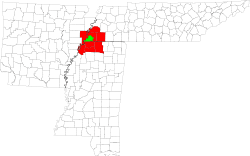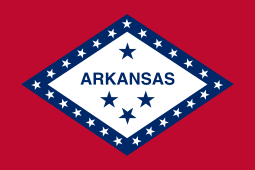Memphis metropolitan area
| Memphis Metropolitan Area | |
|---|---|
| Memphis-Forrest City TN-MS-AR Combined Statistical Area | |
 | |
| Coordinates: 35°N 90°W / 35°N 90°W | |
| Country | United States |
| State(s) |
Tennessee Arkansas Mississippi |
| Largest city | Memphis, Tennessee(656,861) |
| Other cities |
Bartlett, Tennessee(58,264) Southaven, Mississippi(51,824) Collierville, Tennessee(48,655) |
| Area | |
| • Total | 3,013 sq mi (7,800 km2) |
| Population (2013 est.)[1] | |
| • Total | 1,341,746 |
| • Rank | 41st in the U.S. |
| • Density | 426.7/sq mi (164.8/km2) |
The Memphis-Forrest City Combined Statistical Area, TN-MS-AR (CSA) is the commercial and cultural hub of The Mid-South or Ark-Miss-Tenn. The census defined combined statistical area covers ten counties in three states – Tennessee, Mississippi, and Arkansas. As of census 2010 the MSA had a population of 1,324,108 . The Forrest City Micropolitan area was added to the Memphis area in 2012 to form the Memphis-Forrest City Combined Statistical area and had a population of 1,369,548 according to census estimates.[2] The greater Mid-South area as a whole has a population of 2.4 million according to 2013 census estimates. This area is covered by Memphis local news channels and includes the Missouri Bootheel, Northeast Arkansas, West Tennessee, and North Mississippi.[3]
Regional Identity
The Memphis Metro area is known locally as the Mid-South. Culturally the Mid-South is more associated with the Deep South and even more specifically the Mississippi Delta than it is the Upland South, which is the case with Tennessee's other large cities. Memphis is the largest city in the Deep South, third largest in the Southeastern United States, and eighth largest in the Southern United States as a whole. African-Americans make up nearly half the population of the metro area. The Mid-South has the highest percentage of African-Americans of all large metro areas with at least a million people. It is second when metro areas of under a million people are factored in after the Jackson-Vicksburg-Brookhaven, MS Combined Statistical Area. The metro area is blue collar in nature and most of its growth can be attributed to its logisitcal infrastructure. Recently, however, more companies with technology backgrounds such as Electrolux and Mitsubishi have begun making inroads in the Memphis area.[4]
Although Memphis is the cultural and commercial hub of the Mid-South; other cities have become key players as well. These cities include: Jonesboro, Arkansas, West Memphis, Arkansas, Jackson, Tennessee, Martin, Tennessee, Union City, Tennessee, Tupelo, Mississippi, and Oxford, Mississippi.
Economy
The Memphis area enjoys a diverse and robust economy. Well positioned on America's largest river and located near the population center of the United States; Memphis is known as America's distribution hub. FedEx is Headquartered in Memphis and uses the Memphis International Airport as its global superhub facility making the airport the busiest cargo airport in the United States. UPS also uses Memphis as a major hub. The area is also home to one of the United States largest intermodal logistics centers. This includes being the third largest trucking corridor, fourth largest inland port, and third largest in class I railroad services. The Mid-South has the largest percentage of people employed in logistics in the U.S. The Mid-South is also home to many fortune 500 and 1000 companies such as FedEx, AutoZone, Regions Bank, ServiceMaster, BUPERS, First Tennessee and International Paper. Furthermore, companies such as Nike, Baskin Robbins, Sharp, and Hewlett Packard operate large distribution centers out of Memphis.[5]
Healthcare has begun to play a major role in the Mid-south's economy accounting for one in nine jobs. There are nineteen hospitals with over 4,100 beds in the Mid-South. The area is also home to St. Jude Children's Research Hospital which is a nobel prize winning hospital with over 1,200 scientist working there and the University of Tennessee Health Science Center.[5]
Tourism is also a major contributor to the Mid-south's economy with the region being known as the birthplace of Rock and Roll and Blues. Over eight million people visit the Memphis metropolitan area every year for tourist related activities. Over four million people visit Beale Street every year making it the most visited attraction in Tennessee. The Memphis Zoo is one of only four zoos in the U.S. to feature a giant panda and is routinely ranked as one of the best zoos in America. The Tunica casino resort area in Mississippi has over twelve million visitors annually and is the third largest gaming area in the U.S. after Las Vegas and Atlantic City.[5] It also contains a lake beach at Lake Sardis near Batesville, Mississippi.
Colleges and Universities
Four Year Colleges and Graduate Schools
- University of Memphis
- Rhodes College
- Christian Brothers University
- Memphis College of Art
- LeMoyne–Owen College
- Baptist College of Health Sciences
- University of Tennessee Health Science Center
- Southern College of Optometry
- Rust College
- University of Mississippi
- Union University
- Arkansas State University
- University of Tennessee at Martin
- Harding School of Theology
Two Year Colleges
- Southwest Tennessee Community College
- Dyersburg State Community College
- Jackson State Community College
- Mid-South Community College
- Phillips Community College of the University of Arkansas
- Crowley's Ridge College
- Northwest Mississippi Community College
- Coahoma Community College
- Northeast Mississippi Community College
- Itawamba Community College
Transportation
Airports:
- Memphis International Airport
- General DeWitt Spain Airport
- Olive Branch Airport
- University-Oxford Airport
- Jonesboro Municipal Airport
- McKellar-Sipes Regional Airport
Freeways:
- Interstate 40
- Interstate 240 (Inner Beltway)
- Interstate 55
- Interstate 69
- Interstate 269 (Outer Beltway connecting Shelby County to Fayette and DeSoto Counties)
- Interstate 22 (Connects Hickory Hill and DeSoto County, Mississippi, to Birmingham, Alabama, and Atlanta, Georgia)
- Bill Morris Parkway (Connects Piperton, Collierville, Germantown, Southwind, and Hickory Hill to I-240)
- Sam Cooper Blvd (Connects East Memphis and Bartlett to Midtown)
- Tennessee State Route 300 (Located in the Frayser area, connects Watkins and the I-240 loop to U.S. Route 51)
- Interstate 555 (Connects Memphis to Jonesboro, Arkansas)
- Tennessee State Route 14 (Connects Raleigh to Memphis)
Greater Memphis (Mid-South) Counties By State
Arkansas
- Crittenden County* Pop. 49,746
- St. Francis County* Pop. 27,260
- Lee County, Arkansas Pop. 10,015
- Phillips County, Arkansas Pop. 20,399
- Cross County, Arkansas Pop. 17,548
- Poinsett County, Arkansas Pop. 24,145
- Mississippi County, Arkansas Pop. 44,765
- Craighead County, Arkansas Pop. 101,488
- Greene County, Arkansas Pop. 43,097
- Clay County, Arkansas Pop. 15,402
Mississippi
- Benton County* Pop. 8,571
- Desoto County* Pop. 168,240
- Tunica County* Pop. 10,560
- Tate County* Pop. 28,373
- Marshall County* Pop. 36,515
- Panola County, Mississippi Pop. 34,402
- Lafayette County, Mississippi Pop. 51,318
- Alcorn County, Mississippi Pop. 37,316
- Tippah County, Mississippi Pop. 22,084
- Quitman County, Mississippi Pop. 8,223
- Coahoma County, Mississippi Pop. 25,182
- Union County, Mississippi Pop. 27,754
- Lee County, Mississippi Pop. 85,340
- Pontotoc County, Mississippi Pop. 30,897
- Prentiss County, Mississippi Pop. 25,388
Tennessee
- Tipton County* Pop. 61,586
- Shelby County* Pop. 939,465
- Fayette County* Pop. 38,690
- Hardeman County, Tennessee Pop. 26,306
- McNairy County, Tennessee Pop. 26,140
- Madison County, Tennessee Pop. 98,733
- Haywood County, Tennessee Pop. 18,224
- Chester County, Tennessee Pop. 17,321
- Crockett County, Tennessee Pop. 14,591
- Gibson County, Tennessee Pop. 49,457
- Dyer County, Tennessee Pop. 38,213
- Weakley County, Tennessee Pop. 34,450
- Obion County, Tennessee Pop. 31,131
- Lake County, Tennessee Pop. 7,731
Counties marked with* are officially included in the Memphis-Forrest City CSA.
Cities and towns
Places with more than 100,000 inhabitants
- Memphis, Tennessee (Principal City)
Places with 50,000 to 100,000 inhabitants
Places with 25,000 to 50,000 inhabitants
- Collierville, Tennessee
- Germantown, Tennessee
- Olive Branch, Mississippi
- Horn Lake, Mississippi
- West Memphis, Arkansas
Places with 5,000 to 25,000 inhabitants
- Marion, Arkansas
- Hernando, Mississippi
- Lakeland, Tennessee
- Arlington, Tennessee
- Millington, Tennessee
- Atoka, Tennessee
- Covington, Tennessee
- Senatobia, Mississippi
- Holly Springs, Mississippi
- Oakland, Tennessee
- Munford, Tennessee
Places with 500 to 5,000 inhabitants
Places with fewer than 500 inhabitants
Unincorporated places
Demographics
According to U.S.census estimates for 2013,[7] there were 1,371,110 people residing within the CSA. The racial makeup of the CSA was 45.2% non-Hispanic White, 47.3% African American, 0.5% Native American, 2.2% Asian, <0.1% Pacific Islander, and Hispanic or Latino of any race were 5.1% of the population.[7] Memphis is the only metropolitan/combined statistical area in the United States with over a million people to have a plurality/majority African American population.[8] The Jackson, Mississippi metropolitan area also has this distinction but only has around half a million people.
The median income for a household in the MSA was $47,344 and the mean was $65,463. The median income for a family was $57,780 and the mean was $76,126. The per capita income for the MSA was $24,675.[9]
See also
- Tennessee census statistical areas
- Mississippi census statistical areas
- Arkansas census statistical areas
External links
References
| Wikimedia Commons has media related to Memphis metropolitan area. |
- ↑ "Table 1. Annual Estimates of the Population of Metropolitan and Micropolitan Statistical Areas: April 1, 2010 to July 1, 2013" (XML webpage). 2013 Population Estimates. US Census Bureau, Population Division. March 23, 2014. Retrieved July 25, 2015.
- ↑ http://www.policom.com/2013MAPS/Combined%202013.pdf
- ↑ "More than 90,000 Workers Commute from Other Counties to Selby, Census figures show (Commercial Appeal, Apr. 6, 2013)".
- ↑ New Study Forecasts 4000 Local Manufacturing Jobs through 2016
- 1 2 3 http://web.commercialappeal.com/marketing/MemphisData/MemphisMarket.pdf
- ↑ "Southaven population pushes above 50,000-mark (May 23, 2013)".
- 1 2 2013 Census Population Estimate Table
- ↑
- ↑ Profile America Facts for Features, CB12-FF.14, July 24, 2012







.svg.png)
